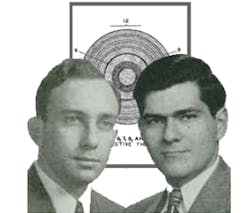Barcode inventor passes away
Norman Joseph Woodland, who created the barcode together with Bernard Silver, passed away this month at his New Jersey home at the age of 91. His daughter Susan Woodland told the New York Times he died from effects of Alzheimer's disease and complications of advanced age.
The barcode the pair invented was first used in grocery stores in 1966 and saw widespread use after the Universal Grocery Products Identification Code was created in 1970 to standardize common grocery items.
It origins go back to 1948, however, when the head of a local grocery store chain came to Drexel Institute of Technology -- now Drexel University (Philadelphia, PA, USA) -- in the hope of tapping the institution's engineering brainpower to develop a way to read product data during the checkout process. At the time, card reading equipment that was used in stores was bulky and expensive.
Early inspirations for the barcode came from Morse code -- a system of dots and dashes used to send coded messages via the telegraph. "I just extended the dots and dashes downwards and made narrow lines and wide lines out of them," Woodland said in a Wonders of Modern Technology article.
To read the codes, Woodland came up with a way of shining light through the lines to a light sensitive tube on the other side that converted the varying brightness of the light coming through the paper into electric signals. Silver crafted the original coding system, which was in the form of a bull's eye so that it could be scanned in any direction.
The engineers filed for a patent on the system on October 20, 1949. Sixty years later, the barcode remains an enduring symbol of technology that has stood the test of time.
Related articles on bar-code reading from Vision Systems Design that you might also be interested in.
1. Vision app repository now available for cameras
Tordivel (Oslo, Norway) has launched a commercial machine vision app repository to enable OEMs to build dedicated vision applications using smart cameras from Sony Europe's Image Sensing Solutions (Stuttgart, Germany) division.
2. Guide explains the basics behind the QR Code
Denso ADC (Long Beach, CA, USA) -- the US sales arm of Denso Wave -- has published a new guide to explain the basics behind the popularly used QR Code.
3. Lumidigm develops new barcode fabrication method to deter counterfeiting
Lumidigm (Albuquerque, NM, USA) has developed a high-resolution pattern that is printed in close proximity to a barcode, that it says cannot be copied by conventional means without producing image artifacts.
-- Dave Wilson, Senior Editor, Vision Systems Design
